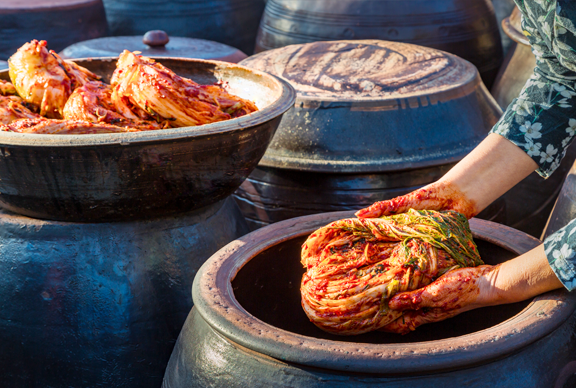Korean culture · customs

Name Culture
The majority of Koreans have one of a small number of family names: Kim (about 21% of all Koreans), Yi (or Lee or Rhee, 14%), Park (or Pak, 8%), Choi (or Choe), Jeong (or Chung), Jang (or Chang), Han, Lim, etc. A Korean name consists of a family name, in almost every case one syllable, plus a given name usually of two syllables. The family name comes first. A Korean woman does not take her husband's family name, but their children take their father's family name.

Jerye (Ancestral Memorial Rite)
According to traditional Korean beliefs, when people die, their spirits do not immediately depart; they stay with their descendants for four generations. During this period the deceased are still regarded as family members, and Koreans reaffirm the relationship between ancestors and descendants through jerye on the special days like Sollal (Lunar New Year's Day) and Chuseok (Korean Thanksgiving Day), as well as on the anniversary of their ancestors' passing. Koreans also believe that people can live well and happily thanks to benefits their ancestors bestow upon them.

Courtesy
Koreans place great importance on courtesy. They bow at the waist when greeting others as the sign of respect. Koreans use both hands when giving food or things to others, especially elders. When you beckon to a person, do so with your palm down, and then flutter your hand up and down with your fingers touching together. It is not polite to beckon with your palm up especially using only one finger, because Koreans do that only for dogs.

Korean Food
A diverse array of food and dishes can be found throughout Korea. Korea was once primarily an agricultural nation, cultivating rice as their staple food since ancient times. These days Korean cuisine is characterized by a wide variety of meat and fish dishes along with wild greens and vegetables. Various fermented and preserved food, such as kimchi (fermented spicy cabbage), jeotgal (matured seafood with salt) and doenjang (fermented soy bean paste) are notable for their specific flavor and high nutritional value. The prominent feature of a Korean table setting is that all dishes are served at the same time. Traditionally, the number of side dishes varied from 3 for the lower classes to 12 for royal family members. Table arrangements can vary depending on whether a noodle dish or meat is served. Formal rules have developed for table setting, demonstrating the attention people pay to food and dining. Compared to neighboring China and Japan, a spoon is used more often in Korea, especially when soups are served.

Gimjang
Gimjang is the age-old Korean practice of preparing winter kimchi, which has been passed down from generation to generation. Since very few vegetables are grown in the three or four winter months, gimjang takes place in early winter and provides what has become a staple food for Koreans. For Koreans, a dinner table without kimchi is unthinkable.

Traditional Korean Clothing (Hanbok)
The hanbok has been the Korean people's unique traditional costume for thousands of years. The beauty and grace of Korean culture can be seen in photographs of women dressed in the hanbok. Before the arrival of Western-style clothing one hundred years ago, the hanbok was everyday attire. Men wore jeogori (Korean jackets) with baji (trousers) while women wore jeogori with chima (skirt). Today, the hanbok is worn on days of celebration such as weddings, Seollal (Lunar New Year's Day) or Chuseok (Korean Thanksgiving Day).

Traditional Korean Houses
A traditional Korean house is called 'Hanok'. Hanok sought to create a living space based on the coexistence of nature and humans. Accordingly, the natural aspects of traditional Korean houses range from the structure's inner layout to the building materials which were used. Another unique feature of traditional houses is their special design for cooling the interior in the summer and heating the interior in the winter. Since Korea has such hot summers and cold winters, the 'ondol gudeul,' a floor-based heating system and 'daecheong,' a cool wooden-floor style hall were devised long ago to help Koreans survive the frigid winters and to make the sweltering and humid summers bearable. These primitive types of heating and air-conditioning were so effective that they are still in use in many homes today.

Ondol
Traditional Korean rooms have multiple functions. Rooms are not labeled or reserved for a specific purpose; there is no definite bedroom or dining room for example. Rather, tables and mats are brought in as needed. Most people sit and sleep on the floor on thick mats. Underneath the floors are stone or concrete flues. Traditionally hot air was vented through the flues to provide heat. Clay or cement would be placed over the stones to protect the residents from noxious gasses. This type of under floor heating is called "ondol." Nowadays hot water is piped through cement floors covered with linoleum.
 Living in Daejeon
Living in Daejeon